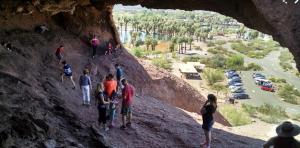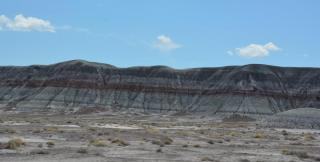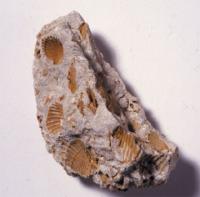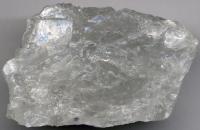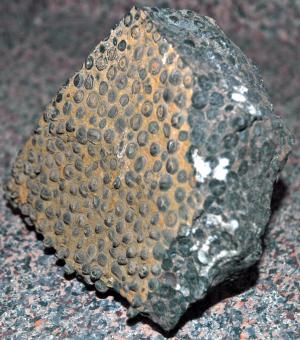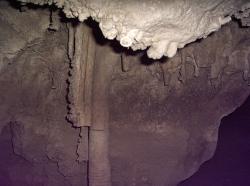Sedimentary Rocks
Sedimentary rocks are the most common rocks on the surface of the Earth. In fact, sedimentary rocks make up about 75 percent of all rock that you see. If you live in Arizona, the percentage is higher. Below are some images where sedimentary rocks are very apparent.
Large Conglomerate Papago Park Phoenix
Sedimentary Ash Layers Petrified Forest
Sedimentary rocks form when layers of sediment, pieces of eroded rock, get pressed, squeezed, and cemented together. When minerals precipitate out of a liquid solution they too can form sedimentary rocks.
Sediments like these turn into...
Rocks like this.
The two main processes that form sedimentary rock are compaction and cementation. Compaction occurs when pressure from overlying sediments presses the sediment below. Spaces between larger rocks are filled in with smaller-sized particles. This is part of the cementation process. Minerals like calcite, hematite, and limonite coming from dissolved rocks and minerals above begin to penetrate into layers below forming natural cement.
Sedimentary rocks form as layers, where the older layers are found on the bottom because they were deposited earlier. Over millions of years, these layers of rock get tilted, cracked, and eroded around creating some of the coolest geologic formations you get to see.
Grand Canyon
Sedimentary rocks are also composed of a bunch of "stuff." They can be composed of minerals, large sediments, small sediments, and even organic materials that we call fossils.
There are three types of sedimentary rock: detrital or clastic, chemical, and organic or biochemical.
Detrital/Clastic: Conglomerate
Organic Sedimentary Rock: Limestone
Chemical Sedimentary Rock: Rock Salt
The word "clastic" actually means broken in pieces. Detritus means small particles so you can see how understanding these two words make it easy to understand that when you have a clastic or detrital rock you are looking at rocks that have visible pieces of other rocks. These rocks have for sure gone through the process of compaction. Ancient environments that form these types of sedimentary rocks are shallow sea beds, sand dunes, river systems, and deltas. Detrital rocks are classified according to the shape and size of sediments. There are four sizes of sediments that help geologists identify the type of sedimentary rock they have. Gravel: ≥2mm, Sand: 1/16mm - 2mm, Silt: 1/256mm - 1/16mm, Clay: <1/256mm. You can tell a lot by understanding the sediment found in these types of rock. Angular sediment means the rocks fell a short distance possibly in some type of landslide or rockfall. Rounded sediment tells you that the rocks traveled quite some distance, rolling around and bumping into each other. The larger the grain size the quicker the sediment was moving and depositing. The smaller the grain size the slower the movement of water.
Chemical sedimentary rocks are formed by precipitation and evaporation. You should recall that these two processes occur when dissolved minerals come out of a solution or are left behind after water has evaporated, leaving layers of these minerals. A great example is found where salt rock is mined. Salt rock was formed after the sold precipitated from ancient sea beds. Examples of chemical sedimentary rocks are oolitic limestone barite and gypsum.
Oolitic Limestone
Organic or biochemical sedimentary rocks are mainly composed of organic material. When many microscopic organisms die and fall to the bottom of the ocean their shells and minerals that make up their shells are left behind. Limestone is formed in such a manner. Coal is another type of organic rock that comes from plants from ancient swamps that died and settled to the bottom, where they rotted leaving the carbon behind. Chert is a relatively smooth piece of rock that is formed from microscopic skeletons and organisms, usually formed in very deep ancient oceans. Chert can also form when wood grain is replaced by silica quartz-like you would find in the Petrified Forest. Petrified wood occurs when ancient floods rapidly bury trees and then minerals such as silica seep into and replace the pieces of wood.
Biochemical: Petrified Wood
Biochemical: Cave Formations
Biochemical: Coal
Now that you understand what sedimentary rocks are and how they formed, let's assess your ability to observe, and make inferences and conclusions about sedimentary rocks.
SUSD5 Version of the Sedimentary Rock Identification Activity
Purchase this activity at Teacher Pay Teacher for 0.50 cents.










